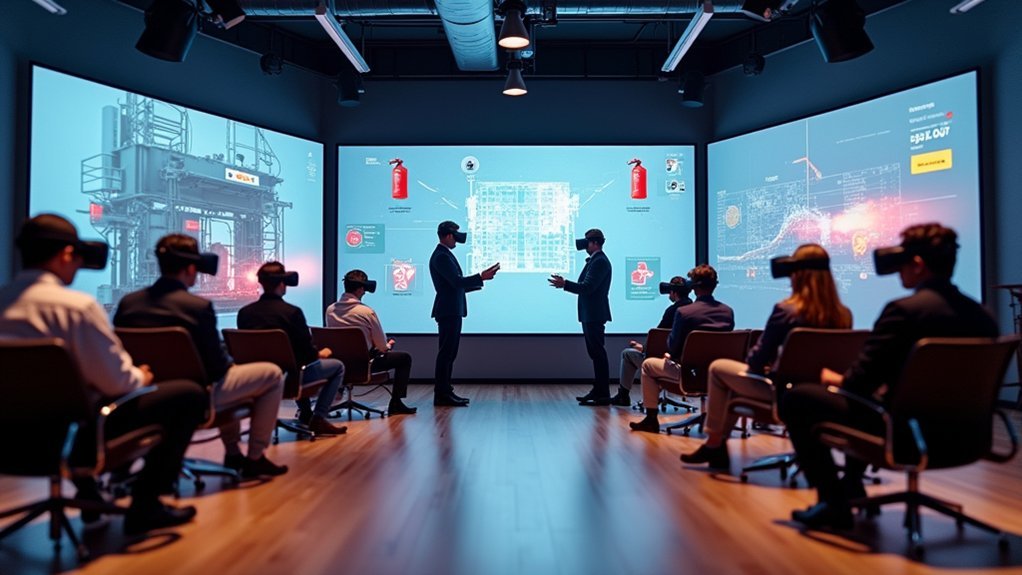You’ll find five leading enterprise VR safety training platforms that can transform your workplace safety protocols. Strivr offers customizable training modules, while VIVE provides extensive virtual instructor-led programs. Oculus for Business delivers robust analytics for performance tracking, and Pixaera specializes in optimizing knowledge retention rates. These platforms can reduce workplace accidents by 43% and accelerate learning by 75% compared to traditional methods. Discover how to select the perfect solution for your organization’s specific needs.
What Are Enterprise VR Safety Training Platforms

Enterprise VR safety training platforms represent a revolutionary shift from traditional safety education methods, leveraging immersive virtual reality technology to create realistic workplace scenarios where your employees can practice critical safety protocols without real-world risks.
These platforms transform employee training through experiential learning, allowing workers to engage with dangerous situations safely while building muscle memory for proper responses.
You’ll find that enterprise VR safety training greatly enhances training effectiveness through built-in analytics and reporting features that track performance metrics.
The integration of gamification elements boosts engagement and motivation, leading to higher completion rates.
This approach strengthens workplace safety by providing hands-on experience that traditional methods can’t match, ultimately preparing your workforce for real-world challenges more effectively.
Key Benefits of Virtual Reality Safety Training for Enterprises
Understanding the capabilities of VR safety training platforms naturally leads to examining their concrete advantages for your organization.
Virtual reality transforms traditional safety training into immersive scenarios that deliver measurable results for compliance and employee engagement.
Your enterprise gains substantial benefits through VR implementation:
- Dramatically reduce workplace accidents – Cut incidents by 43% while protecting your workforce from real-world hazards during training
- Accelerate knowledge retention – Achieve 75% better information retention compared to conventional methods, ensuring critical safety protocols stick
- Streamline onboarding processes – Reduce training time by 40% while maintaining thorough safety preparation for new employees
Virtual reality creates controlled environments where employees practice high-risk situations without physical dangers.
This approach enhances focus levels four times more than traditional training, making your safety programs both efficient and effective.
Essential Features to Evaluate in VR Safety Training Solutions

Look for immersive feedback mechanisms that provide instant evaluations and post-training assessments to reinforce learning outcomes.
Customizable scenarios guarantee training relevance by tailoring content to your industry’s unique hazards and job roles.
Gamification elements like leaderboards and achievement badges boost engagement and motivation.
These features collectively support continuous improvement in safety practices while maximizing your training investment’s return.
Top 5 Enterprise VR Safety Training Platforms
Five leading VR safety training platforms have emerged as game-changers for enterprises seeking to revolutionize their workplace safety protocols.
These solutions deliver immersive learning experiences that transform how you prepare your workforce for high-risk industries.
Strivr leads with customizable VR training modules designed for safety protocols practice, while VIVE offers extensive virtual instructor-led training programs.
Oculus for Business provides robust analytics tools for employee performance tracking, and Pixaera specializes in knowledge retention rates optimization through data-driven insights.
Consider these emotional benefits when selecting your platform:
- Peace of mind knowing your employees train safely without real-world exposure
- Confidence boost from 75% improved knowledge retention rates
- Relief achieving up to 30% workplace accidents reduction
These platforms revolutionize traditional training approaches while delivering measurable safety improvements.
How to Select the Right VR Safety Training Platform for Your Organization

How do you navigate the complex landscape of VR safety training platforms to find the perfect match for your organization’s unique needs?
Start by evaluating thorough content libraries that align with your compliance training requirements and industry-specific regulations.
Prioritize platforms offering real-time performance tracking and robust tracking and reporting capabilities to monitor learner progress effectively.
Assess integration capabilities with your existing learning management system (LMS) for seamless data management.
Look for course authoring tools that enable creating interactive courses tailored to your organization’s needs.
Consider engagement features like gamification elements to boost learner motivation and retention.
Finally, verify the compliance training platform includes customizable certification management capabilities, allowing you to create specific certificates and automated renewal reminders to maintain ongoing compliance standards.
Frequently Asked Questions
What Is the Most Popular Safety Course?
You’ll find OSHA 10-Hour and 30-Hour training are the most popular safety courses. They’re widely recognized, mandated by many organizations, and provide essential workplace safety knowledge for both entry-level workers and supervisors.
What Is LMS in Safety?
LMS in safety means you’ll use a Learning Management System that delivers, tracks, and manages your safety training programs digitally. It guarantees you’re compliant with regulations while providing personalized, accessible training experiences.
What Are the 10 Basic Safety Training Courses?
You’ll need OSHA 10/30-hour training, First Aid/CPR, Hazard Communication, Fire Safety, and Forklift/Heavy Equipment Safety. These courses cover essential workplace protocols, emergency response, chemical handling, evacuation procedures, and equipment operation safety standards.
What Are Examples of Safety Training Programs?
You’ll find safety training programs like OSHA 10/30-hour courses, HAZWOPER’s 40-hour hazardous waste training, New York’s SST construction courses, interactive multimedia programs, and industry-specific training tailored to your workplace needs.





Leave a Reply